-
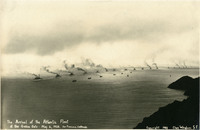 McCarthy Album 06, Photograph 287
McCarthy Album 06, Photograph 287 Inscribed on photograph: "The Arrival of the Atlantic Fleet at the Golden Gate - May 6, 1908. San Francisco, California. Copyright Charles Weidner, S.F." This photograph, by Charles Weidner, shows the U.S. Navy's Atlantic Fleet, consisting of sixteen battle cruisers and various support vessels, steaming toward the Golden Gate and San Francisco Bay. President Theodore Roosevelt ordered the Atlantic Fleet (later called the "Great White Fleet" because the ships were painted white with gold trim) on a tour around the world, beginning in December 1907, to show American goodwill and also demonstrate the power of the U.S. Navy. The Fleet reached the Golden Gate, entrance to San Francisco Bay, on May 6, 1908.
-
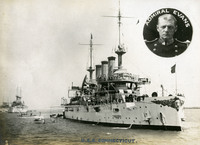 McCarthy Album 06, Photograph 286
McCarthy Album 06, Photograph 286 Caption: "USS Connecticut, Admiral Evans," c. 1908. View of the USS Connecticut, with an inset circular photograph of Admiral Evans. The USS Connecticut was commissioned on September 29, 1906 as the most advanced ship in the U.S. Navy. Because the provisions of the Washington Naval Treaty of 1922 stipulated that older battleships would be disposed of, the Connecticut was decommissioned and sold for scrap in 1923.
-
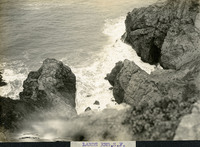 McCarthy Album 06, Photograph 285
McCarthy Album 06, Photograph 285 Caption: "Lands End S.F." Lands End is a rocky shoreline at the mouth of the Golden Gate in San Francisco. Today it is a park within the Golden Gate National Recreation Area
-
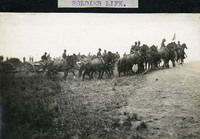 McCarthy Album 06, Photograph 284
McCarthy Album 06, Photograph 284 Caption: "Soldier Life," c. 1910. A view of soldiers on horseback, pulling heavy artillery up an embankment, at an unidentified location.
-
 McCarthy Album 06, Photograph 283
McCarthy Album 06, Photograph 283 Caption: "Solider Life," c. 1910. A view of a group of soldiers, carrying long guns and supplies, and marching in formation at an unidentified location.
-
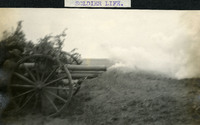 McCarthy Album 06, Photograph 282
McCarthy Album 06, Photograph 282 Caption: "Soldier Life," c. 1910. Unidentified man firing heavy artillery at unidentified location.
-
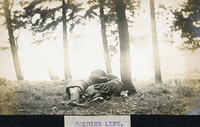 McCarthy Album 06, Photograph 281
McCarthy Album 06, Photograph 281 Caption: "Soldier Life," c. 1910. A view of an unidentified man in military attire, and an unidentified woman, lying on the ground together under a tree, at an unidentified location.
-
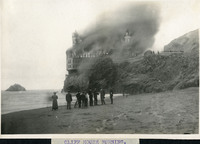 McCarthy Album 06, Photograph 280
McCarthy Album 06, Photograph 280 Caption: "Cliff House Burning," 1907. People standing on Ocean Beach watching the third Cliff House burning in San Francisco, in 1907. The original Cliff House was built in 1858. The second was built in 1863 and was destroyed by fire on Christmas day in 1894. The third Victorian- style Cliff House was completed in 1896, and although it survived the 1906 earthquake and fires, it burned to the ground in 1907, as seen in this image. A fourth Cliff House was then built with steel-reinforced concrete and opened in 1909.
-
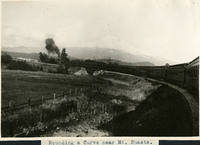 McCarthy Album 06, Photograph 279
McCarthy Album 06, Photograph 279 Caption: "Rounding a Curve near Mt. Shasta," c. 1910. A view of a train rounding a curve in the valley below a snow-covered Mount Shasta, seen in the distance.
-
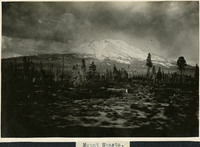 McCarthy Album 06, Photograph 278
McCarthy Album 06, Photograph 278 Caption: "Mount Shasta," c. 1910. A view of snow-covered Mount Shasta, a volcanic peak in the southern part of the Cascade Range in California's Siskiyou County.
-
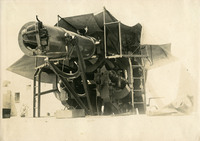 McCarthy Album 06, Photograph 277
McCarthy Album 06, Photograph 277 No caption. A close-up view of a piece of heavy artillery, with a black and white cat standing on it, at an unidentified location.
-
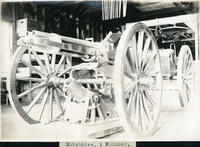 McCarthy Album 06, Photograph 276
McCarthy Album 06, Photograph 276 Caption: "Hotshkiss [sic], 1 pounder." The United States purchased artillery from the French arms firm, Hotchkiss, in the late 19th and early 20th centuries. The arms firm was created by American gunsmith, Benjamin B. Hotchkiss, who moved to France in 1867 to set up the factory. The heavy artillery was first used by the United States against the Nez Perce in 1877. In 1890, they were used at the Wounded Knee Massacre, and also for the attack on San Juan Hill during the Spanish-American War.
-
 McCarthy Album 06, Photograph 275
McCarthy Album 06, Photograph 275 Caption: "Breach of U.S. Rapid Fire."
-
 McCarthy Album 06, Photograph 274
McCarthy Album 06, Photograph 274 Caption: "United States Field Piece." Shows a Civil War-era large gun and carriage at an unidentified location.
-
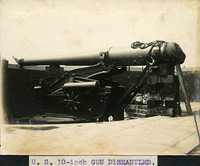 McCarthy Album 06, Photograph 273
McCarthy Album 06, Photograph 273 Caption: "U.S. 10-inch Gun Dismounted." A close-up view of a large gun that has been partially dismounted, at an unidentified coastal defense battery.
-
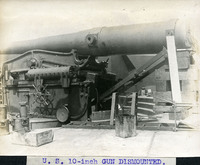 McCarthy Album 06, Photograph 272
McCarthy Album 06, Photograph 272 Caption: "U.S. 10-inch Gun Dismounted." A close-up view of a large gun that has been partially dismounted, at an unidentified coastal defense battery.
-
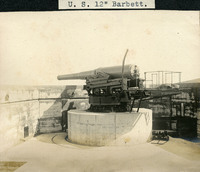 McCarthy Album 06, Photograph 271
McCarthy Album 06, Photograph 271 Caption: "U.S. 12" Barbett [sic]." A view of a barbette (gun emplacement) with a 12" gun, at what appears to be a coastal defense battery.
-
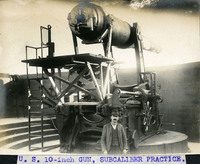 McCarthy Album 06, Photograph 270
McCarthy Album 06, Photograph 270 Caption: "U.S. 1-inch Gun, Subcaliber Practice." c. 1905. William McCarthy poses next to a large piece of heavy artillery at what appears to be a battery for coastal defense.
-
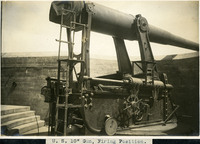 McCarthy Album 06, Photograph 269
McCarthy Album 06, Photograph 269 Caption: "U.S. 10" Gun, Firing Position." A close-up view of a large gun in the firing position at what appears to be a battery for coastal defense.
-
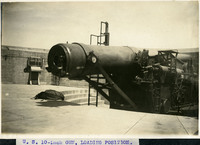 McCarthy Album 06, Photograph 268
McCarthy Album 06, Photograph 268 Caption: "U.S. 10-inch Gun, Loading Position." A close-up view of a large gun in a loading position at what appears to be a battery for coastal defense.
-
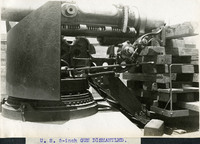 McCarthy Album 06, Photograph 267
McCarthy Album 06, Photograph 267 Caption: "U.S. 5-inch Gun Dismantled." A close-up view of a dismantled large gun at an unidentified location.
-
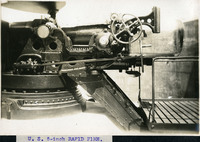 McCarthy Album 06, Photograph 266
McCarthy Album 06, Photograph 266 Caption: "U.S. 5-inch Rapid Fire." A close-up view of a large gun at an unidentified location.
-
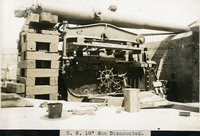 McCarthy Album 06, Photograph 265
McCarthy Album 06, Photograph 265 Caption: "U.S. 10" Gun Dismounted." A view of a large gun at an unidentified location.
-
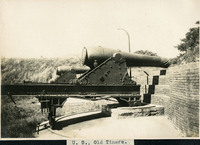 McCarthy Album 06, Photograph 264
McCarthy Album 06, Photograph 264 Caption: "U.S., Old Timers." A view of two large guns in carriages, at an unidentified location.
-
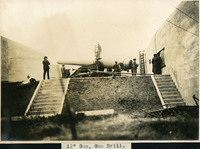 McCarthy Album 06, Photograph 263
McCarthy Album 06, Photograph 263 Caption: "12" Gun, Gun Drill." A view of several unidentified men conducting a gun drill in a coastal defense battery at an unidentified location.
-
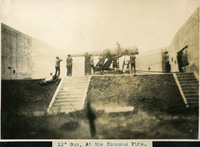 McCarthy Album 06, Photograph 262
McCarthy Album 06, Photograph 262 Caption: "12" Gun, At the Command Fire." A view of several unidentified men working on a large gun in a coastal defense battery at an unidentified location.
-
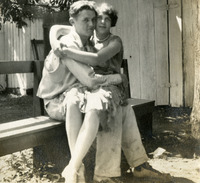 McCarthy Album 06, Photograph 261
McCarthy Album 06, Photograph 261 No caption. An unidentified man and woman sitting on a bench near the Russian River, c. 1920. See also 96-07-08-alb04-227 and 228.
-
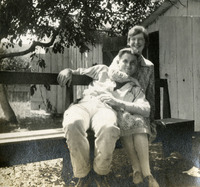 McCarthy Album 06, Photograph 260
McCarthy Album 06, Photograph 260 No caption. An unidentified man and woman sitting on a bench near the Russian River, c. 1920. See also 96-07-08-alb04-227 and 228.
-
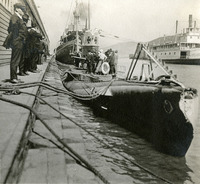 McCarthy Album 06, Photograph 259
McCarthy Album 06, Photograph 259 No caption. See also 96-07-08-alb05-320, with caption: "Damaged German Submarine.," c. 1917. Shows the above-water portions of a German U-boat, or submarine, likely docked in either Petaluma or San Francisco, given the presence of a Petaluma and Santa Rosa Railway ferry in the background. Unidentified group of men standing on what appears to be a submarine.
-
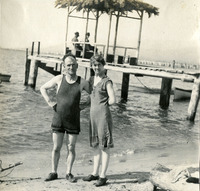 McCarthy Album 06, Photograph 258
McCarthy Album 06, Photograph 258 No caption. William and Grace McCarthy, in swimsuits, standing on the shore of Lake Tahoe, c. 1915. See also 96-07-08-alb04-163.
-
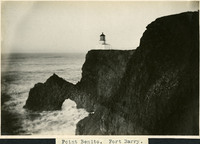 McCarthy Album 06, Photograph 257
McCarthy Album 06, Photograph 257 Caption: "Point Benito [sic]. Fort Barry," c. 1910. A view of the Point Bonita Lighthouse near Fort Barry and the Marin Headlands. The lighthouse, built in 1855, was the third lighthouse built on the West Coast to shepherd ships through the narrow straights of the Golden Gate. The lighthouse, still active today, is maintained by the U.S. Coast Guard, and is part of the Golden Gate National Recreation Area.
-
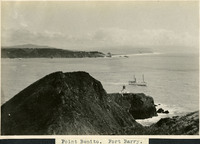 McCarthy Album 06, Photograph 256
McCarthy Album 06, Photograph 256 Caption: "Point Benito [sic]. Fort Barry." c. 1910. A view of the Point Bonita Lighthouse near Fort Barry and the Marin Headlands. The lighthouse, built in 1855, was the third lighthouse built on the West Coast to shepherd ships through the narrow straights of the Golden Gate. The lighthouse, still active today, is maintained by the U.S. Coast Guard, and is part of the Golden Gate National Recreation Area.
-
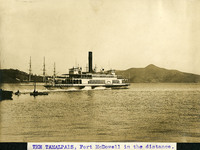 McCarthy Album 06, Photograph 255
McCarthy Album 06, Photograph 255 Caption: "The Tamalpais, Fort McDowell in the distance," c. 1910. The single stack steamer, Tamalpais, cruising on the waters of the San Francisco Bay. Fort McDowell, seen in the distance, is located on Angel , today part of the California State Park system.
-
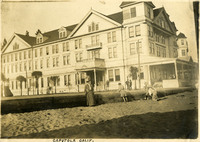 McCarthy Album 06, Photograph 254
McCarthy Album 06, Photograph 254 Caption: "Capitola Calif," c. 1910. Grace McCarthy is seen standing in front of a large building in Capitola.
-
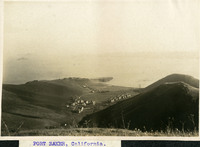 McCarthy Album 06, Photograph 253
McCarthy Album 06, Photograph 253 Caption: "Fort Baker, California," c. 1910. Fort Baker was constructed between 1901 and 1910 to provide permanent housing for the new seacoast fortifications that were built between 1897 and 1905. The men stationed at Fort Baker were members of the Coast Artillery Corps, officially created in 1907 by the U.S. Army to protect and defend the nation's harbors.
-
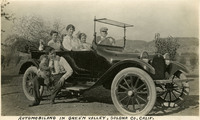 McCarthy Album 06, Photograph 252
McCarthy Album 06, Photograph 252 Caption: "Automobiling in Green Valley, Solona [sic] Co, Calif," c. 1915. William McCarthy in driver's seat, and Grace McCarthy in passenger's seat, with several unidentified people in an automobile in Solano County.
-
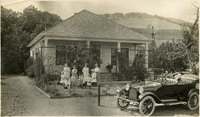 McCarthy Album 06, Photograph 251
McCarthy Album 06, Photograph 251 No caption: Grace McCarthy (standing, second from right), with several unidentified adults and children posing for photograph in front of a small house with a hillside of crops in the distance, and an automobile in the foreground, in Solano County, c. 1910 - 1915.
-
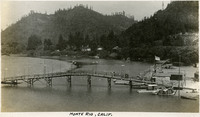 McCarthy Album 06, Photograph 250
McCarthy Album 06, Photograph 250 Caption: "Monte Rio, Calif," c. 1910. A Boat landing and foot bridge at C.W. Meadows' place of business at Monte Rio, along the Russian River in Sonoma County, California.
-
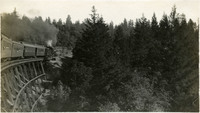 McCarthy Album 06, Photograph 249
McCarthy Album 06, Photograph 249 No Caption. A view of a train crossing over trestle at an unidentified location, c. 1910.
-
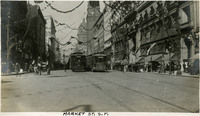 McCarthy Album 06, Photograph 248
McCarthy Album 06, Photograph 248 Caption: "Market St. S.F," c. 1910, shows Market Street in San Francisco, possibly during a parade to celebrate Admission Day on September 9, when California was admitted as a state into the U.S.
-
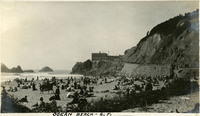 McCarthy Album 06, Photograph 247
McCarthy Album 06, Photograph 247 Caption: "Ocean Beach - S.F," c. 1910, shows a large group of sunbathers on San Francisco's Ocean Beach.
-
 McCarthy Album 06, Photograph 246
McCarthy Album 06, Photograph 246 No Caption. An unidentified man riding a horse at an unidentified location, c. 1920.
-
 McCarthy Album 06, Photograph 245
McCarthy Album 06, Photograph 245 No Caption. Grace and William McCarthy with unidentified young woman, standing on a hillside under a large tree, at an unidentified location, c. 1920.
-
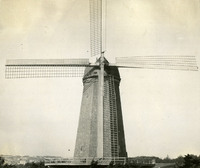 McCarthy Album 06, Photograph 244
McCarthy Album 06, Photograph 244 No Caption. A Dutch Windmill, at unidentified location, likely at San Francisco's Golden Gate Park, c. 1910.
-
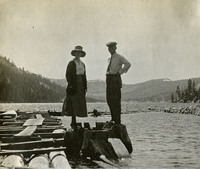 McCarthy Album 06, Photograph 243
McCarthy Album 06, Photograph 243 No Caption. Grace and William McCarthy standing on a tree stump near a dock at an unidentified location, c. 1920.
-
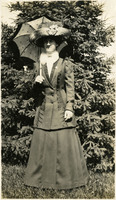 McCarthy Album 06, Photograph 242
McCarthy Album 06, Photograph 242 No Caption. Grace McCarthy posing for a photograph in front of a pine tree, c. 1908.
-
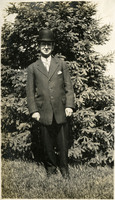 McCarthy Album 06, Photograph 241
McCarthy Album 06, Photograph 241 No Caption. William McCarthy posing for a photograph in front of a pine tree, c. 1908.
-
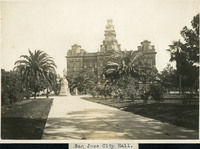 McCarthy Album 06, Photograph 240
McCarthy Album 06, Photograph 240 Caption: "San Jose City Hall," c. 1905, (Theodore Lenzen, Architect), was built in 1889 with a budget of $150,000. The brick and terracotta structure was demolished and replaced in 1958.
-
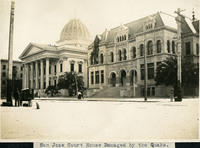 McCarthy Album 06, Photograph 239
McCarthy Album 06, Photograph 239 Caption: "San Jose Court House Damaged by the Quake," c. 1906. A view of the San Jose Courthouse (left), and Hall of Records, which sustained some damage seen along the roofline, as a result of the 1906 San Francisco earthquake
-
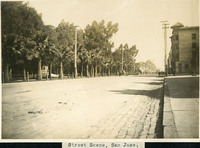 McCarthy Album 06, Photograph 238
McCarthy Album 06, Photograph 238 Caption: "Street Scene, San Jose," c. 1910. A horse-drawn carriage and several pedestrians can be seen in the distance along a palm-lined street in San Jose.
 McCarthy Album 06, Photograph 287 Inscribed on photograph: "The Arrival of the Atlantic Fleet at the Golden Gate - May 6, 1908. San Francisco, California. Copyright Charles Weidner, S.F." This photograph, by Charles Weidner, shows the U.S. Navy's Atlantic Fleet, consisting of sixteen battle cruisers and various support vessels, steaming toward the Golden Gate and San Francisco Bay. President Theodore Roosevelt ordered the Atlantic Fleet (later called the "Great White Fleet" because the ships were painted white with gold trim) on a tour around the world, beginning in December 1907, to show American goodwill and also demonstrate the power of the U.S. Navy. The Fleet reached the Golden Gate, entrance to San Francisco Bay, on May 6, 1908.
McCarthy Album 06, Photograph 287 Inscribed on photograph: "The Arrival of the Atlantic Fleet at the Golden Gate - May 6, 1908. San Francisco, California. Copyright Charles Weidner, S.F." This photograph, by Charles Weidner, shows the U.S. Navy's Atlantic Fleet, consisting of sixteen battle cruisers and various support vessels, steaming toward the Golden Gate and San Francisco Bay. President Theodore Roosevelt ordered the Atlantic Fleet (later called the "Great White Fleet" because the ships were painted white with gold trim) on a tour around the world, beginning in December 1907, to show American goodwill and also demonstrate the power of the U.S. Navy. The Fleet reached the Golden Gate, entrance to San Francisco Bay, on May 6, 1908. McCarthy Album 06, Photograph 286 Caption: "USS Connecticut, Admiral Evans," c. 1908. View of the USS Connecticut, with an inset circular photograph of Admiral Evans. The USS Connecticut was commissioned on September 29, 1906 as the most advanced ship in the U.S. Navy. Because the provisions of the Washington Naval Treaty of 1922 stipulated that older battleships would be disposed of, the Connecticut was decommissioned and sold for scrap in 1923.
McCarthy Album 06, Photograph 286 Caption: "USS Connecticut, Admiral Evans," c. 1908. View of the USS Connecticut, with an inset circular photograph of Admiral Evans. The USS Connecticut was commissioned on September 29, 1906 as the most advanced ship in the U.S. Navy. Because the provisions of the Washington Naval Treaty of 1922 stipulated that older battleships would be disposed of, the Connecticut was decommissioned and sold for scrap in 1923. McCarthy Album 06, Photograph 285 Caption: "Lands End S.F." Lands End is a rocky shoreline at the mouth of the Golden Gate in San Francisco. Today it is a park within the Golden Gate National Recreation Area
McCarthy Album 06, Photograph 285 Caption: "Lands End S.F." Lands End is a rocky shoreline at the mouth of the Golden Gate in San Francisco. Today it is a park within the Golden Gate National Recreation Area McCarthy Album 06, Photograph 284 Caption: "Soldier Life," c. 1910. A view of soldiers on horseback, pulling heavy artillery up an embankment, at an unidentified location.
McCarthy Album 06, Photograph 284 Caption: "Soldier Life," c. 1910. A view of soldiers on horseback, pulling heavy artillery up an embankment, at an unidentified location. McCarthy Album 06, Photograph 283 Caption: "Solider Life," c. 1910. A view of a group of soldiers, carrying long guns and supplies, and marching in formation at an unidentified location.
McCarthy Album 06, Photograph 283 Caption: "Solider Life," c. 1910. A view of a group of soldiers, carrying long guns and supplies, and marching in formation at an unidentified location. McCarthy Album 06, Photograph 282 Caption: "Soldier Life," c. 1910. Unidentified man firing heavy artillery at unidentified location.
McCarthy Album 06, Photograph 282 Caption: "Soldier Life," c. 1910. Unidentified man firing heavy artillery at unidentified location. McCarthy Album 06, Photograph 281 Caption: "Soldier Life," c. 1910. A view of an unidentified man in military attire, and an unidentified woman, lying on the ground together under a tree, at an unidentified location.
McCarthy Album 06, Photograph 281 Caption: "Soldier Life," c. 1910. A view of an unidentified man in military attire, and an unidentified woman, lying on the ground together under a tree, at an unidentified location. McCarthy Album 06, Photograph 280 Caption: "Cliff House Burning," 1907. People standing on Ocean Beach watching the third Cliff House burning in San Francisco, in 1907. The original Cliff House was built in 1858. The second was built in 1863 and was destroyed by fire on Christmas day in 1894. The third Victorian- style Cliff House was completed in 1896, and although it survived the 1906 earthquake and fires, it burned to the ground in 1907, as seen in this image. A fourth Cliff House was then built with steel-reinforced concrete and opened in 1909.
McCarthy Album 06, Photograph 280 Caption: "Cliff House Burning," 1907. People standing on Ocean Beach watching the third Cliff House burning in San Francisco, in 1907. The original Cliff House was built in 1858. The second was built in 1863 and was destroyed by fire on Christmas day in 1894. The third Victorian- style Cliff House was completed in 1896, and although it survived the 1906 earthquake and fires, it burned to the ground in 1907, as seen in this image. A fourth Cliff House was then built with steel-reinforced concrete and opened in 1909. McCarthy Album 06, Photograph 279 Caption: "Rounding a Curve near Mt. Shasta," c. 1910. A view of a train rounding a curve in the valley below a snow-covered Mount Shasta, seen in the distance.
McCarthy Album 06, Photograph 279 Caption: "Rounding a Curve near Mt. Shasta," c. 1910. A view of a train rounding a curve in the valley below a snow-covered Mount Shasta, seen in the distance. McCarthy Album 06, Photograph 278 Caption: "Mount Shasta," c. 1910. A view of snow-covered Mount Shasta, a volcanic peak in the southern part of the Cascade Range in California's Siskiyou County.
McCarthy Album 06, Photograph 278 Caption: "Mount Shasta," c. 1910. A view of snow-covered Mount Shasta, a volcanic peak in the southern part of the Cascade Range in California's Siskiyou County. McCarthy Album 06, Photograph 277 No caption. A close-up view of a piece of heavy artillery, with a black and white cat standing on it, at an unidentified location.
McCarthy Album 06, Photograph 277 No caption. A close-up view of a piece of heavy artillery, with a black and white cat standing on it, at an unidentified location. McCarthy Album 06, Photograph 276 Caption: "Hotshkiss [sic], 1 pounder." The United States purchased artillery from the French arms firm, Hotchkiss, in the late 19th and early 20th centuries. The arms firm was created by American gunsmith, Benjamin B. Hotchkiss, who moved to France in 1867 to set up the factory. The heavy artillery was first used by the United States against the Nez Perce in 1877. In 1890, they were used at the Wounded Knee Massacre, and also for the attack on San Juan Hill during the Spanish-American War.
McCarthy Album 06, Photograph 276 Caption: "Hotshkiss [sic], 1 pounder." The United States purchased artillery from the French arms firm, Hotchkiss, in the late 19th and early 20th centuries. The arms firm was created by American gunsmith, Benjamin B. Hotchkiss, who moved to France in 1867 to set up the factory. The heavy artillery was first used by the United States against the Nez Perce in 1877. In 1890, they were used at the Wounded Knee Massacre, and also for the attack on San Juan Hill during the Spanish-American War. McCarthy Album 06, Photograph 275 Caption: "Breach of U.S. Rapid Fire."
McCarthy Album 06, Photograph 275 Caption: "Breach of U.S. Rapid Fire." McCarthy Album 06, Photograph 274 Caption: "United States Field Piece." Shows a Civil War-era large gun and carriage at an unidentified location.
McCarthy Album 06, Photograph 274 Caption: "United States Field Piece." Shows a Civil War-era large gun and carriage at an unidentified location. McCarthy Album 06, Photograph 273 Caption: "U.S. 10-inch Gun Dismounted." A close-up view of a large gun that has been partially dismounted, at an unidentified coastal defense battery.
McCarthy Album 06, Photograph 273 Caption: "U.S. 10-inch Gun Dismounted." A close-up view of a large gun that has been partially dismounted, at an unidentified coastal defense battery. McCarthy Album 06, Photograph 272 Caption: "U.S. 10-inch Gun Dismounted." A close-up view of a large gun that has been partially dismounted, at an unidentified coastal defense battery.
McCarthy Album 06, Photograph 272 Caption: "U.S. 10-inch Gun Dismounted." A close-up view of a large gun that has been partially dismounted, at an unidentified coastal defense battery. McCarthy Album 06, Photograph 271 Caption: "U.S. 12" Barbett [sic]." A view of a barbette (gun emplacement) with a 12" gun, at what appears to be a coastal defense battery.
McCarthy Album 06, Photograph 271 Caption: "U.S. 12" Barbett [sic]." A view of a barbette (gun emplacement) with a 12" gun, at what appears to be a coastal defense battery. McCarthy Album 06, Photograph 270 Caption: "U.S. 1-inch Gun, Subcaliber Practice." c. 1905. William McCarthy poses next to a large piece of heavy artillery at what appears to be a battery for coastal defense.
McCarthy Album 06, Photograph 270 Caption: "U.S. 1-inch Gun, Subcaliber Practice." c. 1905. William McCarthy poses next to a large piece of heavy artillery at what appears to be a battery for coastal defense. McCarthy Album 06, Photograph 269 Caption: "U.S. 10" Gun, Firing Position." A close-up view of a large gun in the firing position at what appears to be a battery for coastal defense.
McCarthy Album 06, Photograph 269 Caption: "U.S. 10" Gun, Firing Position." A close-up view of a large gun in the firing position at what appears to be a battery for coastal defense. McCarthy Album 06, Photograph 268 Caption: "U.S. 10-inch Gun, Loading Position." A close-up view of a large gun in a loading position at what appears to be a battery for coastal defense.
McCarthy Album 06, Photograph 268 Caption: "U.S. 10-inch Gun, Loading Position." A close-up view of a large gun in a loading position at what appears to be a battery for coastal defense. McCarthy Album 06, Photograph 267 Caption: "U.S. 5-inch Gun Dismantled." A close-up view of a dismantled large gun at an unidentified location.
McCarthy Album 06, Photograph 267 Caption: "U.S. 5-inch Gun Dismantled." A close-up view of a dismantled large gun at an unidentified location. McCarthy Album 06, Photograph 266 Caption: "U.S. 5-inch Rapid Fire." A close-up view of a large gun at an unidentified location.
McCarthy Album 06, Photograph 266 Caption: "U.S. 5-inch Rapid Fire." A close-up view of a large gun at an unidentified location. McCarthy Album 06, Photograph 265 Caption: "U.S. 10" Gun Dismounted." A view of a large gun at an unidentified location.
McCarthy Album 06, Photograph 265 Caption: "U.S. 10" Gun Dismounted." A view of a large gun at an unidentified location. McCarthy Album 06, Photograph 264 Caption: "U.S., Old Timers." A view of two large guns in carriages, at an unidentified location.
McCarthy Album 06, Photograph 264 Caption: "U.S., Old Timers." A view of two large guns in carriages, at an unidentified location. McCarthy Album 06, Photograph 263 Caption: "12" Gun, Gun Drill." A view of several unidentified men conducting a gun drill in a coastal defense battery at an unidentified location.
McCarthy Album 06, Photograph 263 Caption: "12" Gun, Gun Drill." A view of several unidentified men conducting a gun drill in a coastal defense battery at an unidentified location. McCarthy Album 06, Photograph 262 Caption: "12" Gun, At the Command Fire." A view of several unidentified men working on a large gun in a coastal defense battery at an unidentified location.
McCarthy Album 06, Photograph 262 Caption: "12" Gun, At the Command Fire." A view of several unidentified men working on a large gun in a coastal defense battery at an unidentified location. McCarthy Album 06, Photograph 261 No caption. An unidentified man and woman sitting on a bench near the Russian River, c. 1920. See also 96-07-08-alb04-227 and 228.
McCarthy Album 06, Photograph 261 No caption. An unidentified man and woman sitting on a bench near the Russian River, c. 1920. See also 96-07-08-alb04-227 and 228. McCarthy Album 06, Photograph 260 No caption. An unidentified man and woman sitting on a bench near the Russian River, c. 1920. See also 96-07-08-alb04-227 and 228.
McCarthy Album 06, Photograph 260 No caption. An unidentified man and woman sitting on a bench near the Russian River, c. 1920. See also 96-07-08-alb04-227 and 228. McCarthy Album 06, Photograph 259 No caption. See also 96-07-08-alb05-320, with caption: "Damaged German Submarine.," c. 1917. Shows the above-water portions of a German U-boat, or submarine, likely docked in either Petaluma or San Francisco, given the presence of a Petaluma and Santa Rosa Railway ferry in the background. Unidentified group of men standing on what appears to be a submarine.
McCarthy Album 06, Photograph 259 No caption. See also 96-07-08-alb05-320, with caption: "Damaged German Submarine.," c. 1917. Shows the above-water portions of a German U-boat, or submarine, likely docked in either Petaluma or San Francisco, given the presence of a Petaluma and Santa Rosa Railway ferry in the background. Unidentified group of men standing on what appears to be a submarine. McCarthy Album 06, Photograph 258 No caption. William and Grace McCarthy, in swimsuits, standing on the shore of Lake Tahoe, c. 1915. See also 96-07-08-alb04-163.
McCarthy Album 06, Photograph 258 No caption. William and Grace McCarthy, in swimsuits, standing on the shore of Lake Tahoe, c. 1915. See also 96-07-08-alb04-163. McCarthy Album 06, Photograph 257 Caption: "Point Benito [sic]. Fort Barry," c. 1910. A view of the Point Bonita Lighthouse near Fort Barry and the Marin Headlands. The lighthouse, built in 1855, was the third lighthouse built on the West Coast to shepherd ships through the narrow straights of the Golden Gate. The lighthouse, still active today, is maintained by the U.S. Coast Guard, and is part of the Golden Gate National Recreation Area.
McCarthy Album 06, Photograph 257 Caption: "Point Benito [sic]. Fort Barry," c. 1910. A view of the Point Bonita Lighthouse near Fort Barry and the Marin Headlands. The lighthouse, built in 1855, was the third lighthouse built on the West Coast to shepherd ships through the narrow straights of the Golden Gate. The lighthouse, still active today, is maintained by the U.S. Coast Guard, and is part of the Golden Gate National Recreation Area. McCarthy Album 06, Photograph 256 Caption: "Point Benito [sic]. Fort Barry." c. 1910. A view of the Point Bonita Lighthouse near Fort Barry and the Marin Headlands. The lighthouse, built in 1855, was the third lighthouse built on the West Coast to shepherd ships through the narrow straights of the Golden Gate. The lighthouse, still active today, is maintained by the U.S. Coast Guard, and is part of the Golden Gate National Recreation Area.
McCarthy Album 06, Photograph 256 Caption: "Point Benito [sic]. Fort Barry." c. 1910. A view of the Point Bonita Lighthouse near Fort Barry and the Marin Headlands. The lighthouse, built in 1855, was the third lighthouse built on the West Coast to shepherd ships through the narrow straights of the Golden Gate. The lighthouse, still active today, is maintained by the U.S. Coast Guard, and is part of the Golden Gate National Recreation Area. McCarthy Album 06, Photograph 255 Caption: "The Tamalpais, Fort McDowell in the distance," c. 1910. The single stack steamer, Tamalpais, cruising on the waters of the San Francisco Bay. Fort McDowell, seen in the distance, is located on Angel , today part of the California State Park system.
McCarthy Album 06, Photograph 255 Caption: "The Tamalpais, Fort McDowell in the distance," c. 1910. The single stack steamer, Tamalpais, cruising on the waters of the San Francisco Bay. Fort McDowell, seen in the distance, is located on Angel , today part of the California State Park system. McCarthy Album 06, Photograph 254 Caption: "Capitola Calif," c. 1910. Grace McCarthy is seen standing in front of a large building in Capitola.
McCarthy Album 06, Photograph 254 Caption: "Capitola Calif," c. 1910. Grace McCarthy is seen standing in front of a large building in Capitola. McCarthy Album 06, Photograph 253 Caption: "Fort Baker, California," c. 1910. Fort Baker was constructed between 1901 and 1910 to provide permanent housing for the new seacoast fortifications that were built between 1897 and 1905. The men stationed at Fort Baker were members of the Coast Artillery Corps, officially created in 1907 by the U.S. Army to protect and defend the nation's harbors.
McCarthy Album 06, Photograph 253 Caption: "Fort Baker, California," c. 1910. Fort Baker was constructed between 1901 and 1910 to provide permanent housing for the new seacoast fortifications that were built between 1897 and 1905. The men stationed at Fort Baker were members of the Coast Artillery Corps, officially created in 1907 by the U.S. Army to protect and defend the nation's harbors. McCarthy Album 06, Photograph 252 Caption: "Automobiling in Green Valley, Solona [sic] Co, Calif," c. 1915. William McCarthy in driver's seat, and Grace McCarthy in passenger's seat, with several unidentified people in an automobile in Solano County.
McCarthy Album 06, Photograph 252 Caption: "Automobiling in Green Valley, Solona [sic] Co, Calif," c. 1915. William McCarthy in driver's seat, and Grace McCarthy in passenger's seat, with several unidentified people in an automobile in Solano County. McCarthy Album 06, Photograph 251 No caption: Grace McCarthy (standing, second from right), with several unidentified adults and children posing for photograph in front of a small house with a hillside of crops in the distance, and an automobile in the foreground, in Solano County, c. 1910 - 1915.
McCarthy Album 06, Photograph 251 No caption: Grace McCarthy (standing, second from right), with several unidentified adults and children posing for photograph in front of a small house with a hillside of crops in the distance, and an automobile in the foreground, in Solano County, c. 1910 - 1915. McCarthy Album 06, Photograph 250 Caption: "Monte Rio, Calif," c. 1910. A Boat landing and foot bridge at C.W. Meadows' place of business at Monte Rio, along the Russian River in Sonoma County, California.
McCarthy Album 06, Photograph 250 Caption: "Monte Rio, Calif," c. 1910. A Boat landing and foot bridge at C.W. Meadows' place of business at Monte Rio, along the Russian River in Sonoma County, California. McCarthy Album 06, Photograph 249 No Caption. A view of a train crossing over trestle at an unidentified location, c. 1910.
McCarthy Album 06, Photograph 249 No Caption. A view of a train crossing over trestle at an unidentified location, c. 1910. McCarthy Album 06, Photograph 248 Caption: "Market St. S.F," c. 1910, shows Market Street in San Francisco, possibly during a parade to celebrate Admission Day on September 9, when California was admitted as a state into the U.S.
McCarthy Album 06, Photograph 248 Caption: "Market St. S.F," c. 1910, shows Market Street in San Francisco, possibly during a parade to celebrate Admission Day on September 9, when California was admitted as a state into the U.S. McCarthy Album 06, Photograph 247 Caption: "Ocean Beach - S.F," c. 1910, shows a large group of sunbathers on San Francisco's Ocean Beach.
McCarthy Album 06, Photograph 247 Caption: "Ocean Beach - S.F," c. 1910, shows a large group of sunbathers on San Francisco's Ocean Beach. McCarthy Album 06, Photograph 246 No Caption. An unidentified man riding a horse at an unidentified location, c. 1920.
McCarthy Album 06, Photograph 246 No Caption. An unidentified man riding a horse at an unidentified location, c. 1920. McCarthy Album 06, Photograph 245 No Caption. Grace and William McCarthy with unidentified young woman, standing on a hillside under a large tree, at an unidentified location, c. 1920.
McCarthy Album 06, Photograph 245 No Caption. Grace and William McCarthy with unidentified young woman, standing on a hillside under a large tree, at an unidentified location, c. 1920. McCarthy Album 06, Photograph 244 No Caption. A Dutch Windmill, at unidentified location, likely at San Francisco's Golden Gate Park, c. 1910.
McCarthy Album 06, Photograph 244 No Caption. A Dutch Windmill, at unidentified location, likely at San Francisco's Golden Gate Park, c. 1910. McCarthy Album 06, Photograph 243 No Caption. Grace and William McCarthy standing on a tree stump near a dock at an unidentified location, c. 1920.
McCarthy Album 06, Photograph 243 No Caption. Grace and William McCarthy standing on a tree stump near a dock at an unidentified location, c. 1920. McCarthy Album 06, Photograph 242 No Caption. Grace McCarthy posing for a photograph in front of a pine tree, c. 1908.
McCarthy Album 06, Photograph 242 No Caption. Grace McCarthy posing for a photograph in front of a pine tree, c. 1908. McCarthy Album 06, Photograph 241 No Caption. William McCarthy posing for a photograph in front of a pine tree, c. 1908.
McCarthy Album 06, Photograph 241 No Caption. William McCarthy posing for a photograph in front of a pine tree, c. 1908. McCarthy Album 06, Photograph 240 Caption: "San Jose City Hall," c. 1905, (Theodore Lenzen, Architect), was built in 1889 with a budget of $150,000. The brick and terracotta structure was demolished and replaced in 1958.
McCarthy Album 06, Photograph 240 Caption: "San Jose City Hall," c. 1905, (Theodore Lenzen, Architect), was built in 1889 with a budget of $150,000. The brick and terracotta structure was demolished and replaced in 1958. McCarthy Album 06, Photograph 239 Caption: "San Jose Court House Damaged by the Quake," c. 1906. A view of the San Jose Courthouse (left), and Hall of Records, which sustained some damage seen along the roofline, as a result of the 1906 San Francisco earthquake
McCarthy Album 06, Photograph 239 Caption: "San Jose Court House Damaged by the Quake," c. 1906. A view of the San Jose Courthouse (left), and Hall of Records, which sustained some damage seen along the roofline, as a result of the 1906 San Francisco earthquake McCarthy Album 06, Photograph 238 Caption: "Street Scene, San Jose," c. 1910. A horse-drawn carriage and several pedestrians can be seen in the distance along a palm-lined street in San Jose.
McCarthy Album 06, Photograph 238 Caption: "Street Scene, San Jose," c. 1910. A horse-drawn carriage and several pedestrians can be seen in the distance along a palm-lined street in San Jose.